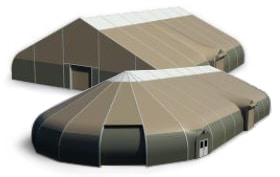Frequently Asked Questions
Here, we answer some of the most frequently asked questions about our product design, features and performance, and what distinguishes Sprung structures from other tension fabric buildings.
What architectural features of the building make it superior?
As evidenced by more than 12,000 installations worldwide, Sprung structures generate lower capital costs, lower energy demands, and lower life-cycle costs.
Built with an up to 25-year guaranteed performance architectural membrane and an up to 50-year guaranteed performance non-corroding aluminum substructure, Sprung structures are known for their exceptional durability and proven long-term performance.
What is a Sprung Structure
Through invention, design and continued innovation, Sprung’s patented membrane structures are the result of decades of research and development. Each Sprung structure features extruded aluminum arches that are integrally connected to an all-weather outer performance architectural membrane. This specialized membrane is certified as flame-retardant.
We engineer our structures to withstand high wind loads and to shed snow. They are expandable and relocatable. They can be fitted with daylight panels, stylish windows and doors, and glazing walls (glass curtain walls) to allow more natural light to penetrate the structure.
With over a century of experience, Sprung delivers the most reliable, versatile and technically advanced structures available in the world.
What about vandalism and security?
Sprung structures are located in some of the world’s most populated regions, and perform extremely well with minimal vandalism.
Our architectural membrane is made out of an interwoven, reinforced ripstop fabric, which makes it highly resistant to tearing and ripping, even if forcefully punctured.
As is the case for any building with windows, properly securing it is the responsibility of the building’s owner or manager. Protecting people, property and information often requires effective screening practices, a security presence, surveillance systems, alarms, motion detectors, proper lighting and other security measures.
An optional 8½-foot-high, vandal-proof, hard-wall shield system is available for extreme security-sensitive applications.
Can a Sprung structure be air-conditioned or heated?
Sprung offers a truly effective insulation system, using multi-layer fiberglass blanket insulation finished with an attractive tensioned interior membrane. This keeps warm air in and cold air out.
What color choices do I have for the membrane?
There are many color options, all of which are rated colorfast and weatherproof. You can even mix and match colors at no additional cost by choosing an attractive wainscot. Colorful graphics, including decorative accent lines and logos, are easy to apply to the Sprung tension fabric membrane.
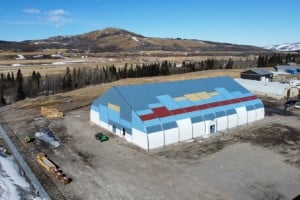
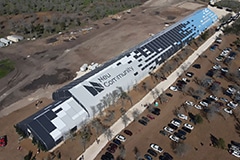
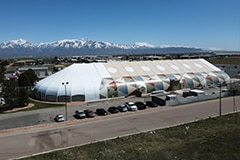
How are the acoustics?
Sprung structures have been used successfully on hundreds of acoustically sensitive applications. The curved profile of the structure creates an interior that is free from conventional flat walls and corners. The soft interior tensioned membrane walls effectively absorb sound, resulting in outstanding acoustic properties.
Does a Sprung structure meet the building code?
Our Sprung structures are designed to meet most building code requirements worldwide.
When you are ready to proceed with ordering a Sprung building, we will supply a comprehensive permit package, complete with drawings and supporting calculations, all stamped by a licensed engineer who is certified in your region.
Who oversees the project?
Once a contractor is chosen, a Sprung Technical Consultant will be supplied on-site to provide advice on the best method of structure assembly and erection, ensuring our commitment to quality is never compromised.
How do mechanical and electrical systems integrate into a Sprung structure?
These systems integrate much the same way as they would with conventional construction. Furnaces and A/C are typically placed on the structure’s exterior and ducted through a Sprung-supplied framed opening in the wall. Lighting, sprinkler lines and ducting are suspended from interior arches with appropriate hangers.
Why are Sprung’s substructures made of aluminum?
While conventional building construction still relies on steel as its primary substructure material, every Sprung structure is built to last with non-corroding extruded aluminum materials. Aluminum substructures offer greater versatility and performance, and they arrive on-site prefabricated and ready to assemble quickly and easily. Plus, because their connections are bolted, no on-site fabrication or welding is needed.
Thanks to their strong and versatile aluminum substructures, Sprung buildings can withstand extreme weather and environmental conditions. Advantages include:
- Rustproof – Unlike steel and wood, aluminum performs extremely well in humid conditions and is maintenance free.
- Lightweight – Aluminum is about 1/3 the weight of steel.
- Strong – Aluminum meets or exceeds building codes for strength.
- Versatile – Aluminum can be extruded into virtually any shape. Connections are butted, not welded.
- Economical – The ratio of strength-to-weight equals more value for less weight.
- Long-lasting – With an indefinite life expectancy, aluminum actually gets stronger with age.
- Environmentally friendly – Aluminum is 100% recyclable, with no generational loss of quality.
Sprung’s aluminum substructure comes with a 50-year guarantee, with an indefinite life expectancy.
What is the specialized tool kit mentioned in my Sprung quote, and what is included in this kit?
Our tool kit provides all specialized hand tools that might be required to erect a Sprung structure, including electric impact wrenches, Hilti concrete drills and specialized hydraulic tensioning devices, as well as dozens of small hand tools. Generators will need to be supplied in locations with no electric power.
Can lightning protection be added to a Sprung structure?
Lightning protection systems can be easily incorporated into the design of a Sprung structure by adding lightning rods (or terminals) to key locations along its peak. If it is determined that lightning is a concern at the location in question, Sprung will recommend a specialist who can help design the protection system.
How long will a Sprung structure last?
Sprung structures are engineered and designed for multi-use applications. With over 12,000 projects, in 100+ countries, our structures are built to last, withstanding extreme weather conditions and extreme situations.
The aluminum substructure has an indefinite life expectancy and a 50-year pro-rata guarantee. Our performance architectural membranes have pro-rata guarantees of up to 25 years and do not need to be re-tensioned.
How does a tear in the membrane affect the tensioning/engineering of a Sprung structure?
Although the membrane does add to the strength of a Sprung structure, the structure is actually fully capable of standing without any membrane. Localized damage to the membrane, or to the aluminum substructure, does not affect the structure’s overall stability or integrity. Damage to one of the panels will have little adverse short-term affect.
What are the expected performance values of a Sprung structure?
Each Sprung structure is designed to meet the building codes and environmental loads of the specific location in which it will be erected. The Sprung team has years of experience designing for durability and performance in the face of all kinds of challenging conditions, including 170-mile-per-hour winds in the Caribbean, 300-pound snow loads in ski areas, extreme summer temperatures reaching north of 50 degrees Celsius (122 degrees Fahrenheit) in the Middle East, and frigid Arctic air exceeding minus 50°C (-58°F).
Can we change or add to the structure in the future?
Yes. The Sprung structure is a prefabricated, modular building design. This allows for easy expansion (by adding modules) or easy reduction (by removing modules), as often as you need.
Read More about Design Flexibility
Can a Sprung structure be attached to an existing building?
Yes. The Sprung structure can easily be attached to an existing building through our sealed connecting corridor system, available in widths of 10′, 14’3″ or 19’2″ (3, 4.4 or 5.8 meters). The structure can also be butted up directly to a conventional building.
For example, during the COVID-19 crisis, regional healthcare organizations needed immediate emergency pandemic facilities that integrated into their campuses. Attaching to existing buildings and adding a connecting corridor systems, ensured seamless integration.
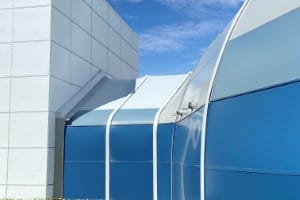
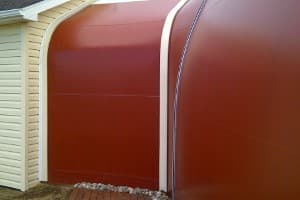
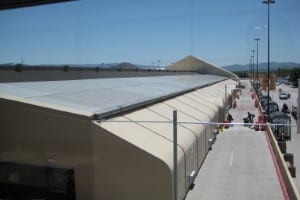
How easy is it to relocate a Sprung structure?
One of the unique characteristics of the Sprung structure is that it can be dismantled, reconfigured and re-erected for almost any number of applications during the life of the structure. This is an easy and cost-effective solution.
Are engineering costs included?
Yes. You do not need to budget anything extra for the engineering of the structure itself, since it is included in the price of your Sprung structure.
Could we build a conventional pre-engineered steel building that costs less than a Sprung structure?
It is very unlikely that you could find a more cost-effective use for your building budget, and a metal building would take longer to design and build. Please refer to our Comparison Matrix for more details.
How fast can a Sprung structure be erected?
Our inventory consists of up to 2 million square feet (185806.1 square meters) of product for immediate delivery.
When appropriate soil conditions exist, no foundation is required for structures up to 160 feet (48.769 m) wide. Little or no ground surface preparation is required.
Structures can be erected at a rate of up to 1,000 sq. ft. (93 sq. m.) per day for insulated structures, and up to 2,000 sq. ft. (186 sq. m.) per day for non-insulated structures (based on an eight hour working day). If an accelerated construction timeline is required, contact your Sprung sales consultant. For example, when TESLA needed to expand their capacity to manufacture the Model 3, they called Sprung. A 915′ long x 150′ wide was erected in just 20 days. Read more TESLA project report
The entire project takes a fraction of the time compared to conventional construction alternatives. Please refer to our Comparison Matrix for more details.
At what point can subtrades begin working inside a Sprung structure?
The big difference between a Sprung structure and other types of construction is that, very early in the erection cycle of a Sprung, all the subtrades have a roof over their heads and can begin their work inside the structure. Trades are not waiting for the end of a long construction cycle to be protected from the weather. On a non-accelerated schedule, usually around day 10, subtrades can begin working under the portions of the Sprung structure that have been erected. This has a huge positive impact on the overall completion schedule.
Does a Sprung structure meet the building code?
Our Sprung structures are designed to meet most building code requirements worldwide.
When you are ready to proceed with ordering a Sprung building, we will supply a comprehensive permit package, complete with drawings and supporting calculations, all stamped by a licensed engineer who is certified in your region.
Is the building energy efficient?
The Sprung building system outperforms other types of construction methods, leading to lower operational costs year-round. Our optional energy efficient fiberglass blanket insulation package performs extremely well. There is almost zero air leakage in a Sprung.
If you have other questions not answered here, please contact us to discuss how we can help you build faster.
Do Sprung structures meet energy code?
Absolutely. Not only does a Sprung structure benefit from having an extremely airtight design, the Sprung team has also developed a number of enhanced insulation solutions to increase the building envelope’s overall insulation value, helping to meet requirements in zones with higher requirements.
Contact your local Sprung sales consultant for more detailed information.
What are the thermal values of the Sprung structure?
Thermal values vary based on a structure’s final design, which is determined by environmental loads at the relevant building site. Specific thermal values can be provided by your Sprung sales consultant once the basic configuration and location of your structure is confirmed.
How does the airtightness of an envelope contribute to overall thermal values?
Airtightness is one of the single largest contributors to the energy efficiency of a building. The positive effects of thick insulation are easily eliminated when a building is not airtight. A Sprung structure will always earn significant points in a performance-based energy analysis thanks to its airtight design.
How does Sprung’s insulation package differ in the structure’s roof versus its walls?
It doesn’t. The insulation thickness in a Sprung structure is consistent from the ground to the peak, which is a bonus when evaluating the overall energy values of the building envelope.
What are the expected performance values of a Sprung structure?
Each Sprung structure is designed to meet the building codes and environmental loads of the specific location in which it will be erected. The Sprung team has years of experience designing for durability and performance in the face of all kinds of challenging conditions, including 170-mile-per-hour winds in the Caribbean, 300-pound snow loads in ski areas, extreme summer temperatures reaching north of 50 degrees Celsius (122 degrees Fahrenheit) in the Middle East, and frigid Arctic air exceeding minus 50°C (-58°F).
